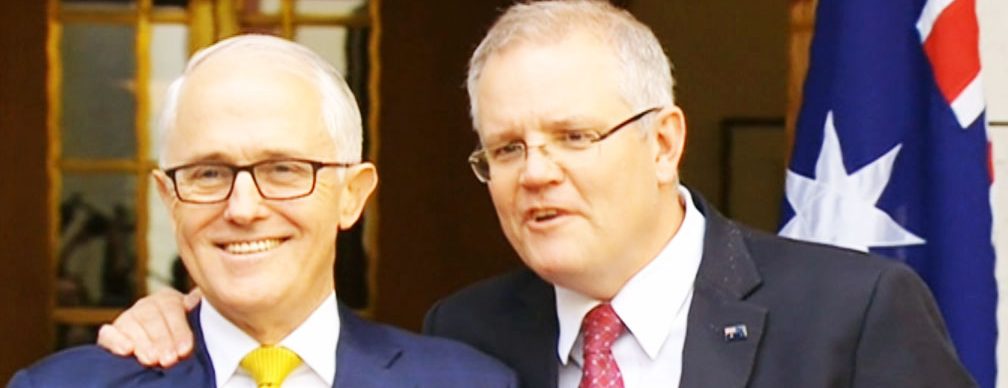The federal Liberal party has a new leader and Australia a new prime minister – the seventh prime minister, indeed, since 2007. The new prime minister is Scott Morrison whose elevation owes everything to an attempt by a not insubstantial proportion of the parliamentary Liberal party to expunge the former leader, Malcolm Turnbull.
The advent of yet another federal leadership coup has precipitated the usual hand wringing about how volatile Australian politics has become, but the cold hard reality is that Mr Turnbull’s demise was foreseeable and perhaps even inevitable. The foreseeability of his being deposed rests on remembering that it had happened once before. In 2009, Malcom Turnbull was party leader when Labor’s Kevin Rudd was prime minister, and it was in the context of Turnbull’s proposal to have the Liberals vote with Labor in the Senate to allow passage of Rudd’s Carbon Pollution Reduction Scheme that led to his being replaced by Tony Abbott in a rather messy ballot that had been called on by former Liberal member Joe Hockey.
There was an eerie similarity in the circumstances of Turnbull’s latest failure and his first removal from the leadership at the hands of his colleagues. In both instances climate change was the policy context in which his leadership was challenged, although in the last spill Turnbull tried to head off his opponents by agreeing to their critique of his freshly minted National Energy Guarantee. This tactic failed simply because the leadership challenge wasn’t about the policy as such. Rather, it was driven by a desire by almost half of the Liberal party room just to get rid of Turnbull.
That desire may well have extended beyond the party room. In justifying their first strike against Turnbull, Peter Dutton and his supporters declared that they were driven by a concern about the dismay about Turnbull amongst the Liberal party “base”. This may be assumed to comprise of Liberal party branch members and/or partisan Liberal voters. The Dutton forces cited the collapse of the Liberal party primary vote in the Queensland seat of Longman at the recent by-election to less than 30 percent, whilst primary support for One Nation rose to nearly 16 percent as prima facie evidence of the Turnbull effect on Liberal support. When added to the Liberal party performance at the 2016 general election in which the Liberal party lost nine seats to Labor, the only conclusion that can be reached is that Malcolm Turnbull is not, and has not been particularly popular with swinging voters either.
If you fail in electoral contests, and you can’t convince at least some of your internal opponents of your qualities of your leadership, and if you constantly stray in to policy areas that are the domain of your political opponents (Australian republicanism, marriage equality and climate change mitigation through the de-carbonisation of the energy sector) then you really can’t expect to survive as the leader of a centre-right political party that contains a large number of social conservatives. This is the reason Malcolm Turnbull is no longer the Liberal leader. It is a much more rational explanation for his demise than accusations of bitterness levelled against Tony Abbott whom he displaced as prime minister ahead of the 2016 election, or of malfeasance on the part of some News Corporation media personalities. Malcolm Turnbull only has himself to blame for his demise. He was never fully embraced by the Liberal party when he made his bid to become the member for Wentworth, and he did not really convince enough of his fellow party travellers that he was a good fit for the modern Liberal party notwithstanding some of the cheering that went on for him amongst some sections of Australia’s well-off, socially progressive upper middle class.
Scott Morrison, meanwhile, is the new leader mainly because he does have the credentials to appeal to the conservative side of his party whilst simultaneously demonstrating loyalty to his former leader and, in doing so, win the support of Turnbull’s supporters in the party. Josh Frydenberg is also a good fir as deputy, partly because he has the support of the economic “dries” in the party who still grieve the rather premature departure of Peter Costello from national politics, and partly because he is from Melbourne. In this transition Julie Bishop – a moderate Liberal from a state Liberal division dominated by hard line conservatives – had to go.
By getting rid of Malcolm Turnbull the Liberal party is actually in much better shape than it has been since Tony Abbott’s landside victory at the 2013 election. The Labor opposition was clearly anticipating a victory for Peter Dutton and the hard line conservatives, Mr Morrison will be a more difficult opponent. The important question for the Liberal party now relates to how the national electorate responds to the latest leadership instability in Australian politics. History suggests that the voters tend to be unforgiving of divided major parties. Mr Morrison needs to try to give the impression that he has healed the rifts and now presents a more unified party. With an election due early next year at the latest, one wonders if he has enough time to try and stave off defeat at the next election.

